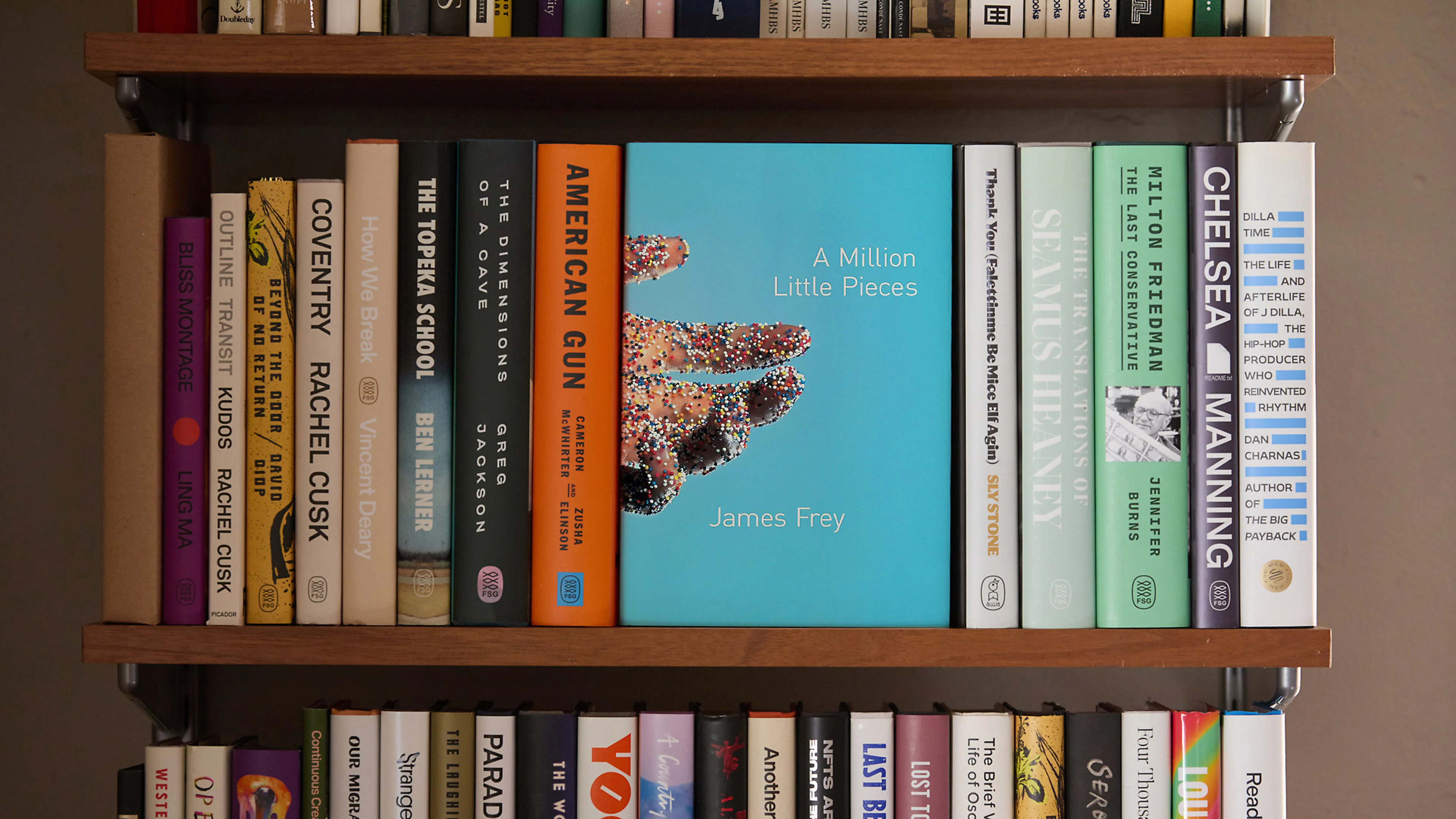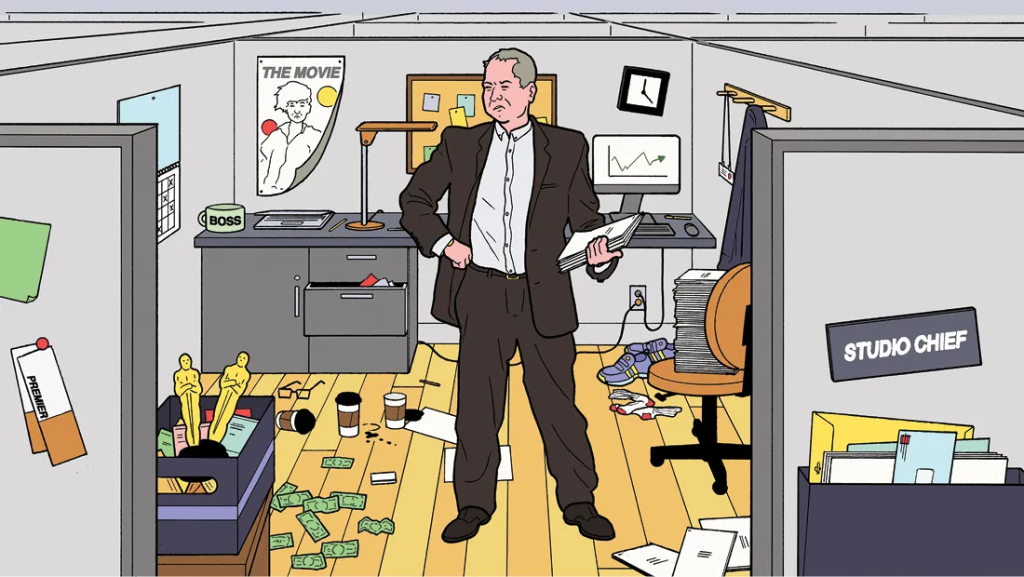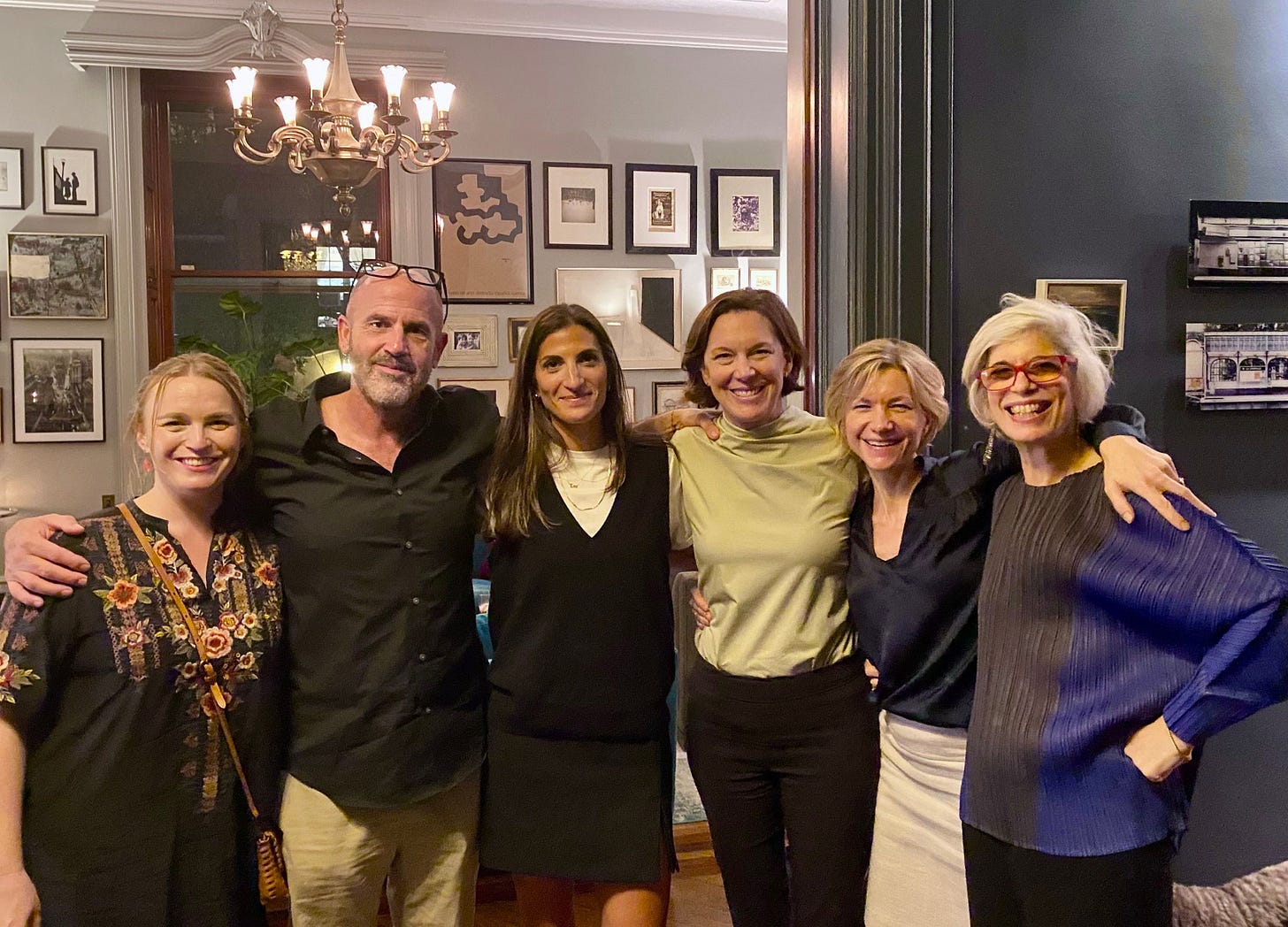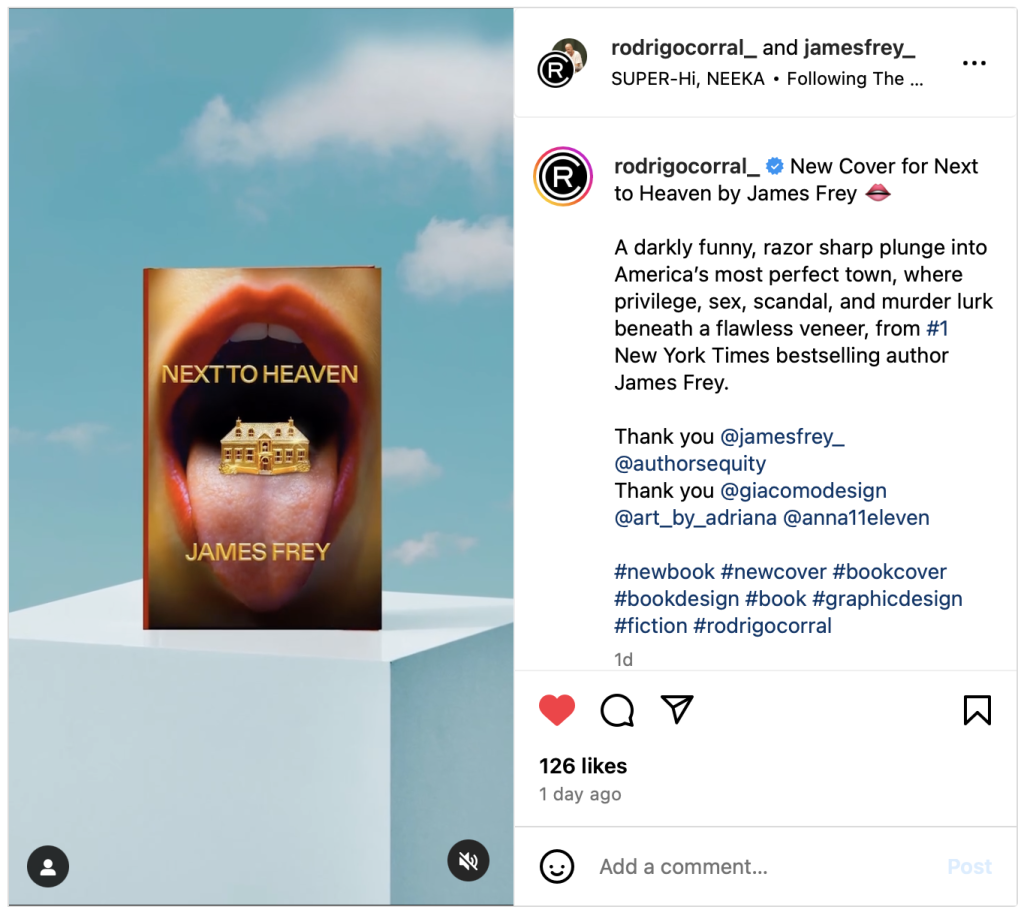NEXT TO HEAVEN Author Talk w/ James Frey
Next to Heaven with James Frey

Wed, Jun 25
Run Time: 60 min.
James Frey, the literary force hailed as “America’s Most Notorious Author” (TIME) and the “Bad Boy of American Literature” (The New York Times), returns with his latest tour de force: Next to Heaven, a darkly funny, razor-sharp thriller that peels back the gilded surface of America’s wealthiest enclaves. This incendiary novel delivers an addictive and voyeuristic plunge into a world where privilege, scandal, and moral decay intertwine, culminating in betrayal, chaos, and murder.
Moderated by best-selling author (and owner of Bedford Books) Fran Hauser.
Murray on Caray on The Cubs
NEXT TO HEAVEN James Frey – (thanks for another iconic cover, Mr. Corral)
Range Media Partners Nabs James Frey
Author James Frey Signs With Range Media Partners

EXCLUSIVE: Bestselling author James Frey has signed with Range Media Partners for representation.
Billed as “America’s Most Notorious Author” by Time magazine, the “Bad Boy of American Letters” by The New York Times, and “America’s Most Important Writer” by Esquire, Frey has written multiple global bestsellers, including A Million Little Pieces, Bright Shiny Morning, and The Final Testament of the Holy Bible. He has sold more than 30 million books and is published in 42 languages.
Frey penned the screenplays for 1998’s Kissing A Fool and Sugar: The Fall of the West, which he also directed. His other film or television work includes 2019’s I Am Number Four (based on his YA sci-fi novel written under the pen name Pitticus Lore) for DreamWorks. He executive produced CBS’ American Gothicdrama series and co-wrote 2019’s crime drama Queen and Slim, on which he also served as a producer. He’s currently adapting his forthcoming novel, Next To Heaven, into a television series for Department M. The novel, billed as “a satirical thrill ride through the dark heart of privilege,” will be published by Authors Equity and distributed by Simon & Schuster on June 17.
F. Scott Fitzgerald’s Gatsby @ 100
One Hundred Years of Gatsby
Editions of The Great Gatsby—which achieved popularity only after F. Scott Fitzgerald’s death—abound, but the mysteries surrounding the Great American Novel endure
BY NATHAN KING

F. Scott Fitzgerald’s final royalty check was for $13.13, making him the recipient of a double dose of bad luck. By 1940, the novel he thought to be his masterpiece, The Great Gatsby, was very nearly out of print, and the woman he regarded as the love of his life, Zelda Fitzgerald, was living across the country, in and out of mental hospitals.
When Fitzgerald died alone, of a heart attack in Hollywood at the age of 44—leave it to the world’s biggest romantic to perish of a broken heart—he considered himself a washed-up failure. The Great Gatsby hadn’t even sold out its initial printing, in 1925, of 23,000 copies, and Fitzgerald was living hand to mouth (the hand was big, but so was the mouth) writing short stories and film scripts. As an author, he was well known to the public but something of a back number. As a man, he was a shell of himself. The American Dream, the Great American Novel, the American Girl—for Fitzgerald, they were all wrapped up together—had eluded him, and not for want of trying.
[ click to continue reading at AIR MAIL ]
Rodrigo Corral (back with James Frey)
Meet the designer behind the look of the 21st-century book
In an industry ruled by #BookTok trends, Rodrigo Corral has become the publishing industry’s go-to designer by creating an undefinable style.

There’s one big thing about Rodrigo Corral that does not initially make sense: The book cover maestro does not have a signature style.
Consider his chameleonic cover hits. The Fault in Our Stars. The Brief Wondrous Life of Oscar Wao. Survivor, Lullaby and the rest of Chuck Palahniuk’s catalog. Rachel Cusk’s books. James Frey’s controversial A Million Little Pieces, the cover that helped launch Corral into ubiquity. Recent collaborative output like Intermezzo and Mojave Ghost. The books don’t have obvious visual connective tissue between them—but somehow, as creative director of Farrar, Straus and Giroux and his eponymous studio, Corral has spent the past three decades quietly redefining the look of the modern book again and again.
The Funk
Who Wants The Funk? ‘We Want The Funk!’ On Doc Talk Podcast With Stanley Nelson & Nicole London
Funk music has been around since the 1960s, developing out of gospel, R&B and soul, with a distinct emphasis on “syncopated bass lines and steady, infectious drum grooves,” according to one description. But that’s an awfully academic way of putting it.
The most important thing: Funk makes you want to dance.
We Want the Funk!, a new documentary premiering Tuesday night on PBS stations, will have you moving in your recliner, on your living room dance floor or wherever you watch it. Directors Stanley Nelson and Nicole London join the latest episode of Deadline’s Doc Talk podcast to explore the music and its key innovators including James Brown, George Clinton and Sly Stone.
Chapter 25 w/ James Frey
Chapter 25: James Frey on drunk, defiant differentiation

What do you know about James Frey?
Or what do you think you know about James Frey?
I’m guessing it’s not nothing. Everyone has an opinion! When I first spotted ‘A Million Little Pieces‘ on my wife’s bookshelf when we were moving in together I was like “Oh? Really? That book? The Oprah guy?”
And she was like “Have you read it?”
And I was like “No, no idea what it’s even about. Just that it’s not real or whatever.”
She looked at me with disappointed eyes. Understandably so! I hadn’t bothered to go below the surface. To read about it on my own. I had just soaked in some distant fumes off the story.
“Read it,” she said, and pushed the book into my hands.
That night I opened ‘A Million Little Pieces’ and was completely pulled into this pulsing, frenetic, endlessly climactic story of addiction, growth, and finding yourself. The book shook me. It was a masterpiece. I couldn’t believe it existed. I almost felt anger towards the Oprah saga because it headfaked me into thinking I knew what the book was about… when I couldn’t have been more off. I went deeper into James Frey’s catalogue and found myself similarly seduced by books like ‘Bright Shiny Morning‘ and ‘Katerina,’ and am looking forward to Frey’s new novel, ‘Next To Heaven,’ which is coming out in June 2025.
White Sands Ancients
‘A real chill’: National park discovery rewrites human history
Evidence of 22,000-year-old vehicles was hiding beneath the sand
By Adrianna Nine, Southwest Contributing Parks Editor
Though it was underwater just 12,000 years ago, White Sands National Park — now an arid desert landscape — abounds with remnants of ancient human history. White Sands Missile Range, a Department of Defense-owned test area surrounding the park, features the world’s largest collection of ice age footprints, which were left behind by people dependent on the region’s bygone lake. Among those footprints, scientists have found new evidence of ancient activity recorded in the sand — and it’s transforming their understanding of early human technology.
These, too, are tracks, but not the kind left by feet. Instead, they belong to travois, the earliest form of terrestrial transportation currently known. Made with long sticks and a basket or net, these primeval vehicles look a bit like a wheelbarrow without the wheel: Pulling the lifted handle or handles moved the basket attached to the sticks, allowing a person to glide heavy cargo across the sand.
Don’t Murder Me
The Science Behind the Return of the Dire Wolf
Nature gave the world the dire wolf 2.6 million years ago, and then, through the hard hand of extinction, took it away—some 10,000 to 13,000 years ago when the last of the species died out. Now, the dire wolf is back, brought bounding into the 21st century by Colossal Biosciences, a Dallas-based biotech company. On April 8, Colossal announced it had used both cloning and gene-editing based on two ancient samples of dire wolf DNA to birth three pups, the six-month-old males Romulus and Remus and the two-month-old female Khaleesi.
“Our team took DNA from a 13,000 year old tooth and a 72,000 year old skull and made healthy dire wolf puppies,” said Colossal CEO Ben Lamm in a statement that accompanied the announcement of the births. “It was once said, ‘any sufficiently advanced technology is indistinguishable from magic.’ Today, our team gets to unveil some of the magic they are working on.”
NEXT TO HEAVEN James Frey – Ready-to-go
The Last Tycoons
The Incredible Shrinking Studio Chief
High-flying execs are dropping like flies right now — at Amazon MGM, and possibly at Warner Bros. — turning what was once the most coveted job in Hollywood into one of the riskiest.

While it seems unlikely that any corner of the entertainment industry will be spared from being skewered during the 10-episode run of Apple TV+’s new satirical comedy series The Studio, the primary vehicle by which its creators interrogate the current malaise afflicting Hollywood is through the eyes of a modern-day studio executive. Like any great satirist, Seth Rogen, who plays an angst-ridden studio chief, is dancing — at times hilariously — around an IRL question: Has there ever been a more challenging and unpleasant time to be a studio executive than today?
It’s undoubtedly a question that former Amazon MGM Studio chief Jen Salke was asking herself March 27 when she was pushed out after seven years on the job. It’s also likely one that Warner Bros. Pictures co-heads Michael De Luca and Pamela Abdy are mulling as they try to swat away rumors that they might be next. And it was on the minds of the dozen current and former executives who spoke to The Hollywood Reporter to vent about their profession.
Barbaric Dosing
Barbarians who toppled Roman Empire were ‘high on hallucinogenic drugs’ at the time
Barbarian hordes invaded and sacked the Western Roman empire while under the influence of hallucinogenic drugs when taking on their enemy, researchers in have suggested
by Michael Havis and Anders Anglesey

Barbarian warriors who toppled the Roman Empire were high on hallucinogenic drugs at the time of their great conquests, according to researchers. The shocking conclusion has come from Polish experts who studied 241 spoon-like utensils found across northern Europe and Scandinavia that were worn on warriors’ belts.
They believe the warriors used them to take drugs such as opium and cannabis, as well as other substances that eased their fears, boosted their aggression and caused hallucinations. Andrzej Kokowski, archaeologist and corresponding author of the new study, said the size of the utensils meant they were impractical for any other use.
OnlyWays
Why would a musician join OnlyFans? Because making a living is only getting harder

Last fall, English singer-songwriter Kate Nash was crunching numbers in between her North American and European tours when she realized she was “essentially going into debt” touring her latest album, 9 Sad Symphonies, as she told NPR. For someone who has been making music and selling out shows for nearly two decades, that was concerning.
Nash first broke out in 2007 with her indie pop album Made of Bricks, which earned her widespread commercial and critical acclaim. Across several more records and a move into acting including a role on Netflix’s GLOW, Nash established herself as a multihyphenate, unafraid of raising some eyebrows. And in November, when she found herself with a pile of unpaid invoices, she came up with a way to make some quick cash: she joined OnlyFans.
Sure, why not?
Can animals make art?
Research led by Shawn Simpson, University of Pittsburgh
In the forests of eastern Australia, satin bowerbirds create structures known as “bowers.” The males gather twigs and place them upright, in two bundles, with a gap in the middle, resulting in what looks like a miniature archway. All around the bower the bird scatters small objects – shells, pieces of plastic, flower petals – which all possess the same property: the color blue.
Studies suggest that the purpose of the bowers is to impress and attract females. But their beauty and intricacy has left some researchers wondering whether they shouldn’t be considered art.
Of course, figuring out whether something is a work of art requires answering some tricky philosophical questions. Are animals even capable of creating art? And how can we tell whether something is a work of art rather than just a coincidentally beautiful object? As a philosopher and artist who’s interested in aesthetics and biology, I recently wrote about the evolution of behaviors in animals that could be seen as art.
The Filthiest
They Own Us
Data Broker Brags About Having Highly Detailed Personal Information on Nearly All Internet Users
The advertising industry is immensely powerful, and disturbingly opaque.
By Lucas Ropek
The owner of a data brokerage business recently put out a creepy-ass video in which he bragged about the degree to which his industry could collect and analyze data on the habits of billions of people.
In 2019, the data broker Epsilon was acquired by French advertising conglomerate Publicis Groupe. Then, earlier this month, Publicis also acquired Lotame, another data and advertising firm, and announced it plans to integrate it with Epsilon’s business. At the time, Publicis CEO Arthur Sadoun said that the new corporate integration would allow his company to deliver “personalized messaging at scale” to some 91 percent of the internet’s adult web users.
Graydon Reflects
from The New York Times via DNYUZ
Graydon Carter and the Golden Age of New York City Media
Lorne. Graydon. Keith. Three abiding kings of New York City’s cultural life are the subjects of new books. Lorne is Lorne Michaels, the creator of “Saturday Night Live,” who is examined under the stereo microscope that is Susan Morrison’s biography, “Lorne.” Graydon is Graydon Carter, a co-founder of the stinging magazine Spy in the 1980s and the editor of Vanity Fair during its plumpest and happiest decades, whose memoir is our topic today. Keith is Keith McNally, the proprietor of that consummate French bistro Balthazar — which is so well run, so well lit and so well victualed that surely one idea of a good death is to deliquesce in one of its red leather banquettes — who has a memoir out soon.
Lorne is 80; Graydon, 75; Keith, 73. Each is still very much in the game. But to have these books in a clump on my coffee table has given me an Auld Lang Syne-ish feeling. An era is approaching its end.
Val Kilmer Gone
Val Kilmer, Star of ‘Batman Forever,’ ‘Tombstone,’ Dies at 65
Val Kilmer, who played Bruce Wayne in “Batman Forever,” channeled Jim Morrison in Oliver Stone‘s “The Doors” and starred as a tubercular Doc Holliday in “Tombstone,” died Tuesday in Los Angeles. His daughter Mercedes told The New York Times the cause was pneumonia. He was 65. He had been battling throat cancer for several years.
Kilmer’s reps did not immediately respond to Variety‘s request for comment.
The baby-faced blonde actor had a solid run as a leading man with a volatile reputation in the ’80s and ’90s, starring in “Top Gun,” “Real Genius,” “Willow,” “Heat,” and “The Saint.” He returned briefly to screens in 2022’s “Top Gun: Maverick” although he could no longer speak due to his cancer.
Bay Rocks
Michael Bay Is Still a Blast (And So Is His “Illegal” New Parkour Movie)
The action icon on his thrilling new documentary ‘We Are Storror,’ the dismal state of Hollywood (“no one can greenlight anything anymore”), that Michael Bay TikTok meme and how Ben Affleck managed to nail the ending of ‘Armageddon.’
Michael Bay is in Miami, which seems right. He also doesn’t exactly love strictly scheduled interviews, and instead just calls when he’s ready to chat, which also seems right. Today, the director of tentpole blockbusters like The Rock and the Transformers franchise is calling to talk about his new parkour documentary, We Are Storror, which is debuting at the 2025 South by Southwest Film Festival this weekend.
Interviewing Bay feels like watching one of his summer tentpole hits. He’s energetic, upbeat and full of boyish humor (and plenty of f-bombs). He’s now 60, but thankfully still sounds like how you expect Michael Bay to sound — like a guy who is still ready to blow some shit up (“Oh, you live in Austin?” he asks, “I burned down a house there once!”).
Fuck Rock
from Authors Equity
You can’t hand-deliver books to Rock Center.
And other lessons from our first year.

Hi, all.
A year ago today, I was part of a tiny sleep-deprived band setting out on the streets of midtown Manhattan to test a theory. The theory was simply this: after chasing scale for most of our corporate careers, we thought we could get further faster by running the other way.
Instead of getting big, we’d go deep. Deep into a small list of books with a small list of authors. Instead of leaning on organizational heft, we’d see how far organizational agility would get us.
We met with a host of literary agencies all around town and basically said: trust us, we can do this, really. It’s a miracle anyone said yes — but enough of them did that it let us take our first steps, make our first books, sell our first books, achieve our first bestsellers.
We’ve added a few colleagues, but we can still all fit on a zoom screen and around the table in our one-room office. Still small by any normal definition of company size. But when you add the authors who’ve embraced us and the partners of all kinds who’ve helped us, we feel big indeed.
Invisible X-37B
Top secret US spaceship returns to Earth after 434 days on mysterious mission… and is met by hazmat-clad ground crew
The spaceship performed a never-before-seen “invisible” manoeuvre
by Lydia Doye

The X-37B Orbital Test Vehicle-7 landed at the Vandenberg Space Force Base in California where it was met by hazmat-clad ground crew.
The spaceship began its return to Earth after successfully completing its “test and experimentation objectives”.
The X-37B completed a never-before-seen aerobraking manoeuvre to change its orbit.
Aerobraking involves making several passes into the Earth’s atmosphere which causes drag to rapidly change the craft’s orbit.
In doing so, the spaceship expends minimal fuel, making it temporarily invisible to other nations who could be tracking it.
Greatest Goal Ever
Hackman Gone
from The Atlantic
There Was Never a Movie Star Like Gene Hackman
Story by David Sims
In 1956, an aspiring young actor named Gene Hackman joined the Pasadena Playhouse in California, struggling to find a way into a field he’d been fascinated with since childhood. Hackman, who was born in 1930, had already served five years in the Marine Corps, then bounced around New York, Florida, Illinois, and other places without much luck. His good friend at Pasadena was another ambitious performer, Dustin Hoffman; together, they were voted “least likely to succeed” by their peers before washing out and moving back to New York to try scratching out a living. Even at the age of 26, Hackman’s hardscrabble features meant he looked like the furthest thing from a marquee idol—he seemed destined to be a bit player at best.
But over the next 50-odd years, Hackman would become the greatest, coolest, earthiest star of what’s now known as New Hollywood: an everyman who defined a generation of moviemaking better than anyone else.
[ click to continue reading at The Atlantic n
Addicto-Weed
Is Weed More Addictive Than We’ve Been Led to Believe?
Turns out cannabis dependence is real — and recovery doesn’t follow the usual script

As a millennial, I’ve seen the reputation of potheads elevate from burnouts buying incense and Grateful Dead shirts at the mall to successful adults who don’t drink but enjoy unwinding and having a good time. The legalized cannabis era has even cultivated a surprising conversational common ground. That family member you’re hoping doesn’t bring up politics at dinner? They’d love to talk gummies instead.
At the same time, ever since I was a teenager (buying incense at the mall), I’ve heard the same refrain over and over again: weed is not addictive. To be honest, that never felt entirely true. I mean, just because my high school friends could make gravity bongs did not make them experts on this topic. Admittedly, we had no clue what we were talking about. As for the weed-smoking community outside my circle of friends, there are over 360,000 users in the subreddit r/leaves, an online group for people trying to quit or seeking support in their recovery, who would beg to differ with the assessment that cannabis is not addictive.
Saunders’ Release
A Treasure Trove of Old Master Works Could Fetch $120 Million or More This May
The auction of fifty-six works once owned by Thomas A. Saunders III and his wife Jordan is expected to break the record set by the $76 million Fisch Davidson collection sale in 2023.

In May, Sotheby’s will present a dedicated auction featuring one of the most significant Old Masters collections to come to market in recent years. Assembled by Thomas Saunders III and his wife, Jordan Saunders, the collection is expected to achieve between $80 million and $120 million. Comprising fifty-six works, Elegance & Wonder: Masterpieces from the Collection of Jordan and Thomas A. Saunders III is expected to break the record for any Old Masters sale at auction, surpassing the $76 million benchmark set by the Fisch Davidson collection in 2023.
“The Saunders were extremely dedicated, determined collectors. They collected Old Masters in earnest and were solely focused on buying what they loved, with a real eye for beauty and a focus on quality,” Wachter told Observer. “They assembled a one-of-a-kind collection spanning still life, landscapes, portraits and more. Helping to assemble their collection is a true bright spot in my career, and it was an honor for me to help guide them through their collecting journey.”
The Blue Ghost
Sunrise on the moon! Private Blue Ghost lander captures amazing shot after historic lunar touchdown (photo)
By Andrew Jones

Firefly Aerospace’s Blue Ghost lander has captured a gorgeous shot of sunrise on the moon as it begins its workday on the lunar surface.
Blue Ghost aced its lunar landing attempt on Sunday (March 2), setting down close to Mons Latreille, a solitary lunar peak in the vast basin Mare Crisium (“Sea of Crises”) in the northeastern region of the moon’s near side.
And the spacecraft is already getting to work, starting up its science payloads and capturing amazing images of its surroundings and the distant Earth from the lunar surface.
The Great Nike Robbery
Inside the Mojave Desert train heists targeting Nike sneakers
by Alex Wigglesworth

The thieves stealthily board eastbound freight trains, hiding out until they reach lonely stretches of the Mojave Desert or high plains far from towns. They slash an air brake hose, causing the mile-long line of railcars to screech to an emergency stop.
Then, they go shopping.
That’s the modus operandi described by investigators in a string of at least 10 heists targeting BNSF trains in California and Arizona since last March. All but one resulted in the theft of Nike sneakers, their combined value approaching $2 million, according to investigators.
Tom & Iggy Smoke Cigarettes
AI Crocs
Crocs just found the perfect use case for AI
AI Jibbitz are here. Dream big.

There are plenty of questionable examples of companies shoehorning useless artificial intelligence features into their products (Meta’s AI-powered profiles say hello!), but finally, Crocs has found one that actually makes sense. The casual footwear brand has partnered with ABLO, an AI fashion design platform, to let people use AI to design their own Jibbitz charms.
Crocs are already all about customization, a strategy that’s helped Crocs, Inc. grow its revenue 4% over last year. Jibbitz charms, which can be plugged into the holes on the shoes’ upper and heel strap, add an extra layer of personalization, and AI takes that to the next level.
“We have Jibbitz for everyone—from teachers to gamers to healthcare workers—and we are now giving our fans the option to design one-of-a-kind charms using ABLO’s AI technology, taking customization to the next level,” Crocs brand president Anne Mehlman tells Fast Company.


